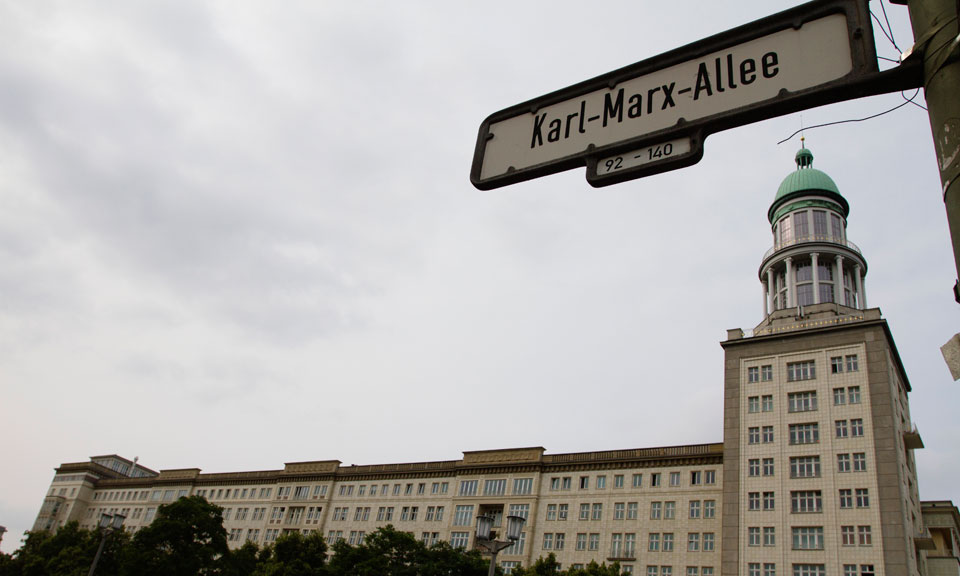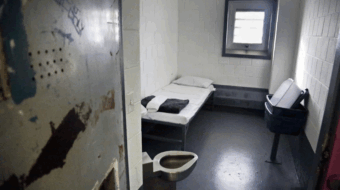
BERLIN—When East Berlin, then the capital of the German Democratic Republic (East Germany), was reunited with West Berlin 29 years ago, thousands living along Karl Marx Allee had no idea what was about to happen to them. Their comfortable publicly owned, low-rent apartments were soon to be snatched up by private real estate firms and their rents would soar.
Fed up with landlords raising rents and not making repairs, tenants in hundreds of apartments along the famous boulevard started protesting and demonstrating two years ago, demanding to go back to the way it was before—low-cost, affordable public housing. When they learned that Deutsche Wohnen, an even worse private owner than the ones they were dealing with, was planning to buy up their apartments, they said, “Enough is enough.”
By Christmas 2018, the protest signs hanging from windows along the boulevard outnumbered the Christmas lights and decorations—and that’s saying a lot for a German city during that holiday season.
Victory came four weeks ago when the state of Berlin, one of 16 in Germany, announced that it was kicking out the private landlords and taking over 670 apartments along the boulevard. The announcement is being celebrated as the most significant victory so far in the battle against privatization and gentrification in Berlin.
The building of the Karl Marx Allee apartments was the first successful step by the socialist GDR to radically improve the housing situation in Berlin after World War II. The grand boulevard stretches from Alexanderplatz, the city center of Berlin, to the Friedrichshain neighborhood further east. The entire city center was in the former East Berlin.
Derided at first by West Berlin authorities as a Stalinist remake of East Berlin into a copycat version of Moscow, the street became the target of real estate developers and gentrifiers after the fall of the Berlin Wall. Although rents rose along the boulevard as soon as the West took over, they remained far lower than the greedy real estate developers would have liked, thus the eventual plans for a takeover by Deutsche Wohnen.
In late fall 2018, Predac, the owner of the buildings, announced that it had gotten an offer it couldn’t refuse from Deutsche Wohnen and was selling the apartments. Tenants, expecting big rent increases, hung banners out their windows and won an initial victory when the Berlin Senate blocked the sale.
It took more than just the mass protests, as essential as they were, to lay the groundwork for that first victory, however, and then the re-nationalization that happened four weeks ago. And that additional thing was the victory two years ago in the Berlin elections of the city’s first Red-Red-Green coalition. The Social Democrats, the Left Party (Die Linke), and the Greens had enough votes combined to form a government. The city’s 15 senators, five from each of the three parties, were all on the side of the tenants. The city senator appointed to be in charge of housing was Katrin Lompscher, one of the five from the Left Party.
The mayor, Michael Müller, comes from the Social Democratic Party. Although the votes received by each of the coalition parties were fairly close, the Social Democrats came in first, the Left Party was second, and the Greens third, giving the Social Democrats the right to choose the mayor.
The mechanism agreed upon for the “re-nationalization” is that the state-owned housing provider, Gewobag, is technically purchasing the apartments. The amount of the reimbursement paid to the private owners could end up costing as much as 90 million euros, all of which will come back to the state in rents.
Müller differs in major respects from people in the national leadership of his party who have formed a “Grand Coalition” with the conservative Christian Democrats. The Social Democratic mayor is with those in his party who see collaboration with Christian Democrats as not having always worked out to the benefit of their party, and in Berlin, the mayor has worked instead with the Left Party and the Greens. Christian Democrats in Berlin, needless to say, do not support programs to take over privately owned housing. He says that it is the policy of his party to continue on a path of re-nationalizing apartments that were privatized in the 1990s following the end of the German Democratic Republic.
But the mass movements of Berlin tenants aren’t satisfied with just those public takeovers. There is support building for two additional initiatives, a five-year rent freeze and a total state takeover, the “expropriation,” as it is called, of Deutsche Wohnen.
While Die Linke is supporting both of these initiatives, tenants across the board are involved, regardless of political party, in the campaigns. Signature collection is underway which, if successful, will require the Congress, the Berlin state legislative body, to vote on the rent freeze. Takeover of Deutsche Wohnen also would have to pass the legislature, and a campaign is underway to collect signatures to get the Congress to take that up also.
Müller wants to be seen as strongly in support of tenant rights. “Berliners should be able to continue to afford living in the city,” he said. “That is why it was and continues to be our intention to buy up apartments wherever we can so that Berlin can regain control of its property market.”
Privatization and gentrification have affected even the poorest Berlin neighborhoods, like Wedding, a long-time working-class district in the northwestern part of the city.
Right up until Hitler was named chancellor in 1933, and well into the 1930s, Nazis arriving by the truckload to intimidate locals in Wedding would regularly get beaten up. After the Second World War, French soldiers (Wedding ended up in the French occupation zone of post-war Berlin) would also get beaten up in the neighborhood bars by residents who were unimpressed that the French were “protecting” them from the Russians in East Berlin.
The West Berlin “economic miracle” was not as evident in Wedding as it was in other parts of West Berlin as the post-war years rolled on. Unlike other neighborhoods in West Berlin, the houses in Wedding remained grey and in need of paint jobs. By the 1980s, the neighborhood was known for some of the worst crime rates in Berlin, with the occasional body of a murdered individual dug up out of a neighborhood park.
Now the houses are being painted—blue, yellow, green and red—and, like in other neighborhoods, the poor artists who came into Wedding in the 1980s, along with folks who lived there before, are being pushed out of their lofts, which are being turned into expensive apartments.
A drinker who may have had a beer too many told me in one of the old neighborhood bars still operating in Wedding that “because some asshole slops some new paint on the walls does not entitle him to become a millionaire and raise up the rents and push people out.” He says he is resisting moving in with his daughter in Wilmersdorf (another Berlin neighborhood) because “she doesn’t like drinking and smoking.”

Marcel Schmidt, a 40-year-old diabetic, lives in Steglitz, another part of Berlin where the rents are still lower than the average. The rent for his small place is 385 euros, but things are tight for him because he is disabled and his monthly pension is only 700 euros, leaving him with just 315 per month for everything else. He is in a rent-controlled apartment, but even there, the rent can be raised up to 10 percent every two years.
He is happy about the tenant victory on Karl Marx Allee, however, and is hopeful about the success of the rent freeze and expropriation campaigns.
“Deutsche Wohnen and some of these others take over and the way they get you out is that they don’t make repairs,” Schmidt said. “Wait a while, they say, and they delay and they don’t make the repairs and when they do they charge more.”
Pongtron Nakornsri, 40, whose family originates from Thailand, lives in the higher-rent neighborhood of Charlottenburg where he was born. He lives in a two-bedroom apartment with two of his aunts where they pay 1,900 euros a month.
Nakormsi agrees that public control “might be the only way that people can afford to be able to live here.” He wanted to make a special point about immigrants living in Berlin. “This housing issue, the rising rents should teach us,” he said, that it is powerful companies, like real estate giant Deutsche Wohnen, and not immigrants or people from Syria who are the problem. It is the [neo-Nazi party] AfD and the extreme right wing who are the problem because they try to get people to fight one another over cultural differences instead of fighting together for affordable housing.”










